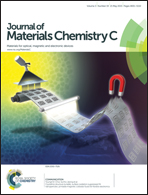Triazine-phosphine oxide electron transporter for ultralow-voltage-driven sky blue PHOLEDs†
Abstract
1,3,5-Triazine derivatives xTPOTZ with aryl phosphine oxide (APO) groups at the ortho-, meta- and para-positions were designed and prepared to demonstrate an APO modification strategy for developing n-type semiconductors. Optical analysis showed that the involvement of APO groups can barely alter the excited state characteristics of xTPOTZ, rendering their triplet energy greater than 2.95 eV for effective exciton blocking in sky blue phosphorescent organic light-emitting diodes. The strong electron-withdrawing effect of P![[double bond, length as m-dash]](https://www.rsc.org/images/entities/char_e001.gif) O can effectively enhance the electroactivity of the materials, on the basis of a suitable substitution configuration. mTPOTZ and pTPOTZ with low-lying lowest unoccupied molecular orbitals at ∼−3.4 eV show improved electron affinity, as well as a lowered highest occupied molecular orbital at −6.6 eV for effective hole blocking. The estimated electron mobility of mTPOTZ and pTPOTZ reaches the order of 10−4 cm2 V−1 s−1. Furthermore, owing to the strongest intramolecular interactions and the exposed triazine core under para-substitution configuration, pTPOTZ achieves the lowest LUMO at −3.46 eV and the highest μe of 3.4 × 10−4 cm2 V−1 s−1, which are among the highest values reported so far for high-energy-gap electron-transporting materials (ETM). As a result, pTPOTZ endowed its typical mCP and FIrpic-based sky blue PHOLEDs with an ultralow onset voltage of 2.5 V and favourable external quantum efficiency up to ∼20%, revealing the effectiveness of APO modification for high-performance ETM development.
O can effectively enhance the electroactivity of the materials, on the basis of a suitable substitution configuration. mTPOTZ and pTPOTZ with low-lying lowest unoccupied molecular orbitals at ∼−3.4 eV show improved electron affinity, as well as a lowered highest occupied molecular orbital at −6.6 eV for effective hole blocking. The estimated electron mobility of mTPOTZ and pTPOTZ reaches the order of 10−4 cm2 V−1 s−1. Furthermore, owing to the strongest intramolecular interactions and the exposed triazine core under para-substitution configuration, pTPOTZ achieves the lowest LUMO at −3.46 eV and the highest μe of 3.4 × 10−4 cm2 V−1 s−1, which are among the highest values reported so far for high-energy-gap electron-transporting materials (ETM). As a result, pTPOTZ endowed its typical mCP and FIrpic-based sky blue PHOLEDs with an ultralow onset voltage of 2.5 V and favourable external quantum efficiency up to ∼20%, revealing the effectiveness of APO modification for high-performance ETM development.


 Please wait while we load your content...
Please wait while we load your content...